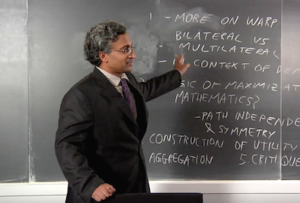Sanjay G. Reddy is an Associate Professor of Economics at The New School for Social Research where he teaches microeconomics. Raphaele Chappe is currently pursuing her PhD at The New School, where her research areas include finance and wealth inequality. Together they are teaching a new online course, “Advanced Microeconomics for the Critical Mind,” aiming to get graduate students thinking about microeconomics in a new way, emphasizing a plurality of viewpoints, thinking across disciplines, and encouraging a critical approach to supposedly settled topics. For them, the questions are as interesting as the answers.
Lynn Parrmore: You say your course is different from the way microeconomics is usually taught. What exactly makes it so?
Raphaele Chappe: Microeconomics is one of the core courses in a Ph.D curriculum. It’s highly technical in nature. Typically, teachers don’t focus on debates in the field and proceed as if everything is settled. There is not a lot of reference to alternative perspectives in the economics literature, or even in other literature in the social sciences. We think that a lot of the assumptions embedded in the toolkit of axioms and the results and so on are open to question. Our goal is to highlight the view that topics in microeconomics could be debated if one were to take a more holistic approach and to look to literature outside of economics, perhaps.
Students often leave an advanced course in microeconomics longing for something more. You feel like you’ve spent a lot of time and energy mastering the technical apparatus but not enough time is spent reflecting on the assumptions or the results. We try to use as little and as much math as is required to go through the standard results, but then actually take the time to examine what has been uncovered in those results. I think it is quite an original approach that is not typically done.
Sanjay Reddy: In recent years, a lot of the macroeconomic models at the heart of controversy about economic policy or regulation have been claimed to be what economists call “micro-founded,” meaning that they aim to provide a description of the macroeconomy that reduces to the action of the individual agents — consumers and firms. This approach was based on the appeal to the prestige of microeconomics as a field, in which there appeared to be considerable agreement about things work and how to model individual agents.
We were asked by the Institute by New Economic Thinking to, and wanted to, present a course on microeconomics that addressed standard arguments but put their point of view in a more critical perspective. Raising questions about microeconomics is also a way of raising questions, indirectly, about macroeconomics and about all of the big issues that matter in economic policy debates that the Institute is deeply concerned about. That’s why this is so important: it’s the linchpin of the economics curriculum and has a bit of a bootcamp atmosphere in graduate schools. People are really a bit afraid of the course sometimes, or they do very well and it gives them a certain sense of confidence as they go on that this is the right foundation. But what we want to say is, look, this isn’t like physics. It’s not something that’s entirely agreed upon. It might look beautifully consistent and mathematically pure, but in fact, there are lots of substantive questions we should be asking and we’re not asking.
LP: You’ve discussed the need to reconsider the idea of rationality. What’s wrong with conventional approach?
RC: The view of rationality in economics is typically presented as consistency in decision-making. We show that it’s not immediately obvious why rationality reduces to consistency interpreted in a narrow way. There is actually a lot of behavior that is conceivably reasonable that may not be reduced in this way. The assumption is that you have a complete space of commodities that people are choosing from and they know what their preferences are. They are able to rank these commodities, decide what they like best, least, and so on, and have reason to stick to those rankings. And the rankings are transitive, so you never contradict yourself. It’s like you’ve already decided everything about the world.
SR: It’s a bit like thinking of people as computers.
RC: In the real word, many times, preferences may not be fully formed, yet this is taken for granted in economics. We think that there is behavior that could be modeled as obeying certain social norms, for example. It might lead you to have what economists might view as contradictory behavior. But we might think, actually, the behavior makes sense and it’s reasonable. Sanjay argues, referring to the work of Amartya Sen and others, for a broader view of rationality — having good reasons to do what one does. The narrow view may be convenient in terms of modeling, but isn’t necessarily always right.
SR: Convenience often means simply fitting into the mathematical framework. Economists would often say that where preferences come from isn’t our question —it’s something psychologists deal with. But it might really matter where preferences come from especially if you think that things like advertising or other economic phenomena affect consumer preferences and consumer demand. This is the kind of broadening we are interested in. We think it’s important to get economic questions right, even where it means we have fewer ready answers.
LP: Which of the problems of the mainstream approach to microeconomics poses the biggest challenge?
RC: Failing to be very explicit about why assumptions are made and to be honest that they already carry in them a very strong commitment to a certain view of the world. When you read textbooks it can feel as though you are being presented something as if it is almost Newtonian in nature almost, so there’s no room left for debate.
SR: And I think often that’s the function microeconomics plays in the discipline at large. A lot of microeconomists engaged in frontier research might not view it that way, but the way in which it’s appealed to in economics teaching and in the professional formation of economists is often to shore up the impression of the claimed scientificity of economics across its various fields and applications. That is precisely what we’re trying to help overcome, by making a small contribution to pluralizing the field.
LP: Do you think the picture of the consumers and firms in typical microeconomics courses is very far from reality?
SR: Raphaele spoke earlier about how human beings are actually very often unsure of what they would like and are learning who they are and what they want in the process of living —interacting with other people, trying things out, etc. We view human beings as much more incomplete fundamentally, and not just as children, but as adults. They are revising who they are and open to various stimuli and influences — advertising, as I mentioned earlier, is just one of them. That, then, would affect what we think about the nature of consumer demand. But in the early chapters of a typical microeconomics textbook, even at the advanced level, you wouldn’t see much, if any, reference to that. Rather, the whole framework is based on the idea that people have fixed preferences. So does it matter to consumer demand? Yes. This year’s Nobel Prize was just won by somebody who worked on consumer demand, but I would say he worked very much within the mainstream perspective in this respect.
There are a lot of other questions. It’s not that the questions which are addressed using the standard framework are unimportant, but the notion that these are the only questions really limits how we approach the analysis of empirical economic phenomena. If we wanted to really get at how the price of breakfast cereals influences the demand for breakfast cereals, for instance — I’m picking that example because it’s something that well-known economists have actually worked on — then it might be that the standard model works out well. But if we’re thinking about something else, about fashion, for instance, it might be a really bad model. We might need a completely different point of view about that.
RC: The theory of the firm is the counterpart to this. The firm is portrayed as this input/output box and the decision-making is simply characterized as the problem of choosing the output level, given available technology, that will maximize profits. This of course is somewhat of a reductionist approach. In the real world, real firms may be engaged in other things than just maximizing profit. They face the problem of the development of technology and how to position themselves in a changing competitive landscape. If you want to understand Apple, it’s not sufficient to simply say that Apple maximizes profit. Apple is also trying to develop the technology of the future. So that’s one limitation. Firms also face the problem of survival in world of uncertainty—trying to stay in existence can be the primary driver. This would be an alternative characterization that wouldn’t be found at all in the traditional textbook. Arguably, this matters a lot in the contemporary world as some of the scholars affiliated with the Institute, such as Richard Koo, Perry Mehrling and Katharina Pistor, have argued about the impact of high levels of indebtedness on firms’ investment behavior and other actions since the crisis.
LP: Do you think poverty poses a special problem for micro?
SR: That is a subject of research interest for me, something that I work on a lot. We mention it in the course as an example of an area in which the positive and the normative, as economists say — or facts and values — come together intrinsically. There’s no way of separating them fully in relation to certain domains. Poverty is a case, and there are others in public policy, where there is a hybrid content to the concerns that we have. The concepts we need to employ to make progress in such an area of application (such as the poverty line) necessarily have both faces, evaluative and empirical, braided within them. As the philosopher Hillary Putnam put it, one can make a distinction, but not draw a dichotomy.
To assess how many poor people there are in the United States for example, it wouldn’t be right to pick some arbitrary money value for income or consumption—you’d have to rather ask the question, what do people really need in order to achieve certain basic things that one would like them to be able to achieve to be able to call them not poor? Once you start with that value framework, then everything else follows about how you should go about identifying them and measuring or estimating the number of poor — such as where they live and how their numbers change over time. That would be an example of that interdependence. I think that there are a lot of other public policy issues of this kind and many of them, though not all, involve microeconomics. In light of the interconnection of fact and value in regard to a number of these topics, which means that it’s perfectly right and appropriate that we should have debates about value as well as debates about facts, together. Economists shouldn’t be ashamed about it. They shouldn’t push it to one side because they think that it’s unscientific. They shouldn’t disdain it because they think it belongs to the work of some other discipline or soft-headed persons. On the contrary, that should be part and parcel of the training of economists — to deal with such questions, without being able to refuse or resolve them (which may require, if it is possible at all, evaluative reasoning and the results of democratic deliberation).
LP: What would be the main takeaway you want students to have from this course?
RC: We’re hoping to familiarize students with a body of literature that they may not have encountered within economics, and from related field such as sociology or psychology or history or other social sciences, even evolutionary biology. Success would be to inspire a new generation of students to open up their intellectual interest and curiosity to other fields and find their relevance for microeconomics and for economics generally as well as to move microeconomics incrementally in new directions and to help to encourage new paths of research by students and junior scholars.
SR: Our goal is in some sense to inoculate students against the view that just because microeconomics, or indeed economics in general, takes a mathematical form, that therefore it’s unassailable. A large part of what we want to do is to say, look, you can have an argument that takes this form but which is still wrong or rests on shoddy foundations. You have to at least be aware of the possible questions about such a framework even if in the end you still offer it a qualified embrace, or even an unqualified embrace. You’re welcome to do that, but let’s not pretend that there are no questions to be asked or answered or that there couldn’t be other viewpoints. If students are inoculated in that way, it will change the way they do research and think about public policy and what should inform it.
For example, right now, behavioral economics is very influential in the public policy world — the idea of nudging people towards certain outcomes. I think very often behavioral economics involves fairly small modifications of the standard view, but it’s an example of how changing your viewpoint about what people do will affect what you think is relevant policy and how you argue about how to do policy. I think one can go well beyond that, and one should. That’s what new economic thinking ought to be about. This has nothing to do with the question of whether or not to use mathematics, of what form and at what level. Rather, our concern is wholly different: what are the right substantive questions and what are the different possible ways in which we might be able to answer them? If it is important to teach and learn a given standard model because of its influence in the prevailing “language game” of economists or for reasons of understanding the world, what questions might we ask about that model, and what other possibilities might this dialogue suggest?








